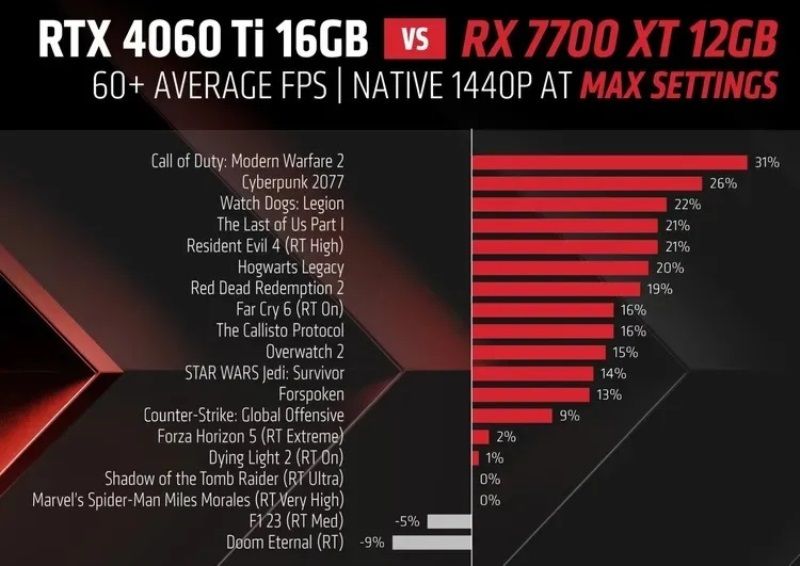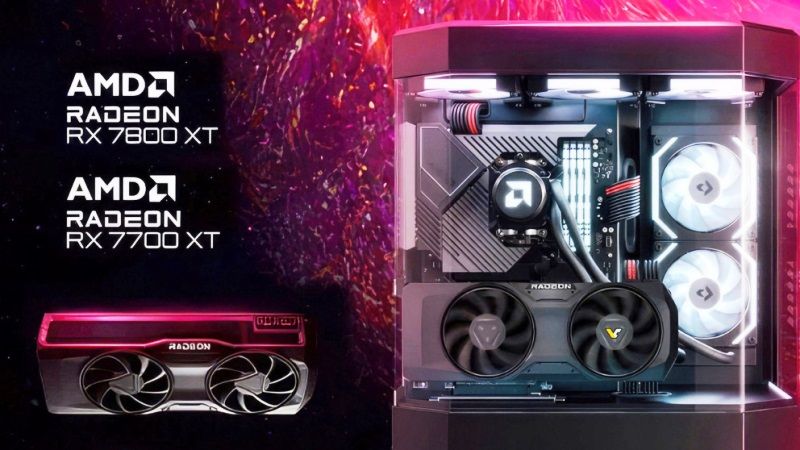AMD officially recently announced its Radeon RX 7700 XT and Radeon RX 7800 XT graphics cards. The rumors were confirmed, and it was presented in the middle of Gamescom 2023. In the article below, we are going to see its technical specifications and its position in the market.
AMD RX 7800 XT and RX 7700 XT GPU Announced

AMD has just made the presentation of the new AMD RX 7800 XT and RX 7700 GPUs, focused on 1440p gaming and with great detail in the characteristics, but there is absolute silence regarding the price.
The AMD Radeon RX 7700 XT arrives to compete with the RTX 4060 Ti. It comes with a unique 12GB VRAM solution, rather than the 8/16GB chosen over at NVIDIA, and the idea is to provide the best value GPU for 1440p at 60+ FPS.
As we see in the image above, the 7700 XT beats the RTX 4060 Ti in most games, some even with RT enabled, by margins of up to 31%. It would be necessary to see the differences if we do not have native resolution by activating DLSS and FSR 2, which is where the comparison could be complicated for AMD.
As for the AMD Radeon RX 7800 XT, it arrives to compete with the RTX 4070 and again provides more VRAM with 16GB versus 12GB for NVIDIA’s option.
The performance is superior in many games, but here we already see that in average terms the difference between the two GPUs is more limited. If we average all the values from these comparisons, we find that the 7700 XT 12GB is 16% better than the 4060 Ti 16GB on average, and the RX 7800 XT 16GB is 3% better than the RTX 4070 on average.
This difference seems similar to the difference between the RTX 4070 and the RX 6800 XT, which gives us an indication that the improvement from one generation to the next will not be very noticeable.
Specifications, prices and availability
As for the specifications, they are in line with the latest rumors. That number of CUs on the RX 7800 XT is what seems a bit bare, considering that the 6800 XT carried 80, like the current 7900 GRE. Obviously, an RDNA 2 CU is not the same as an RDNA 3 CU, but the difference is not huge either.
We are going to show you how the RX 7000 line looks after these two launches:
| RDNA 3 GPUs | RX 7600 | RX 7700 XT | RX 7800 XT | RX 7900 XT |
|---|---|---|---|---|
| GPU | Navi 33 | Navi 32 | Navi 32 | Navi 31 |
| Compute units | 32 | 54 | 60 | 84 |
| Game clock | 2250MHz | 2171MHz | 2124MHz | 2000MHz |
| Boost clock | 2655MHz | 2544MHz | 2430MHz | 2400MHz |
| GDDR6 memory | 8GB | 12GB | 16GB | 20GB |
| Memory interface | 128-bit | 192-bit | 256-bit | 320-bit |
| Memory speed | 18Gbps | 18Gbps | 19.5Gbps | 20Gbps |
| Infinity Cache | 32MB | 48MB | 64MB | 80MB |
| TDP | 165W | 245W | 263W | 315W |
| US MSRP | $269 | $449 | $499 | $899 |
So the key is going to be in the price. And which one is it? Well, we just don’t know. AMD has not specified this in the press details received, and we will certainly update this article as soon as we know anything.
